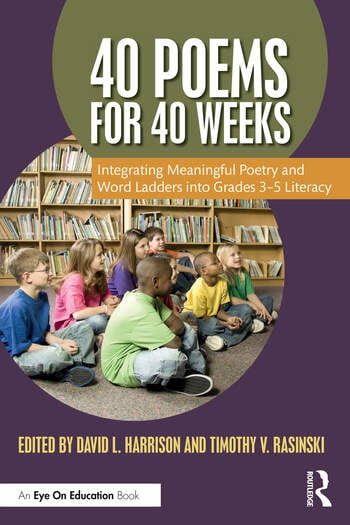40 Poems for 40 Weeks: Integrating Meaningful Poetry and Word Ladders into Grades 3-5 Literacy edited by David L. Harrison and Timothy V. Rasinski; Routledge Eye on Education, 2025.
This month, in recognition of National Poetry Month, I am pivoting from featuring a single children’s book to introducing an anthology of forty poems written for children by well-known, beloved poets. With this handy, accessible resource, teachers and librarians as well as homeschoolers can introduce poetry targeting students in Grades 3–5 on a regular basis, nurturing a love of the art throughout the school year. As the title indicates, this resource offers 40 poems for 40 weeks, so choose to read the poems weekly throughout the year, select randomly, or pick a poem to reinforce a theme, address a need, or celebrate an event. Included at the back of this handy resource is a list of 120 books of poetry, making this an excellent source for poetry titles.
Poetry can “make you remember what you didn’t know you knew.”
~ Robert Frost
Why this book? Why will it matter to kids?
With this resource intended to be used throughout the school year, educators can easily access poetry that will resonate with middle grade students. With repeated exposure, poetry becomes a familiar form of expression, more easily understood, and beloved. Word ladders accompany each poem, offering additional instructional value utilizing decoding and encoding, vocabulary, spelling, and word study skills. Students begin at the top of the ladder and are led from one word to the next by adding or subtracting letter(s) from the previous word to reach the final word at the bottom. Example below.
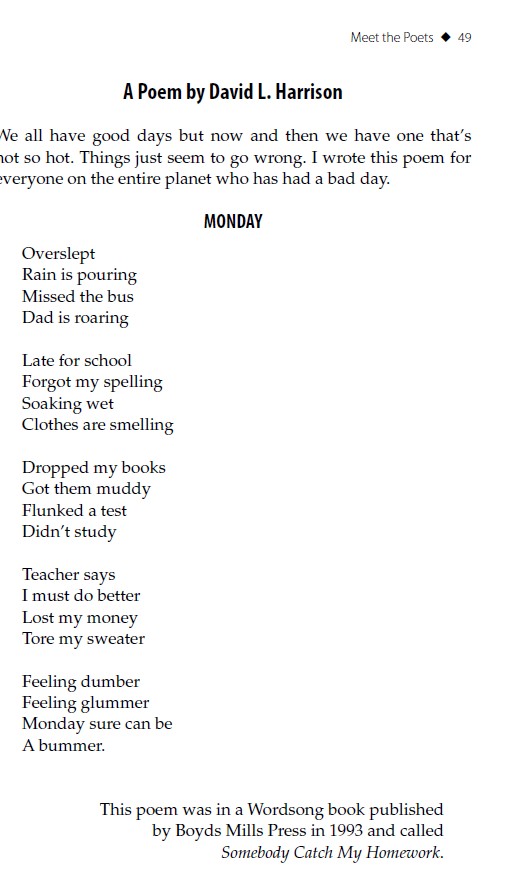
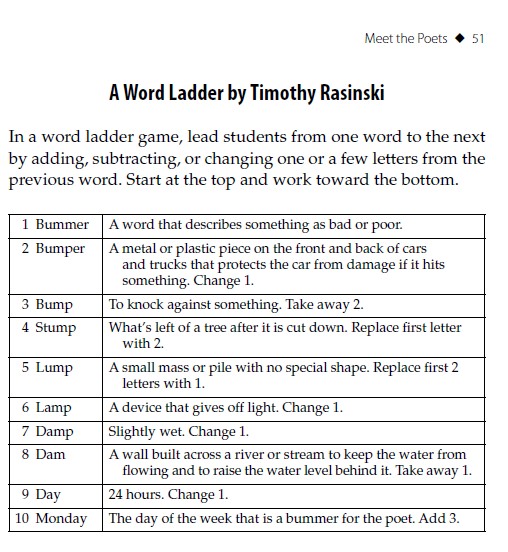
Why read aloud?
We gather to share a book. We settle into a safe space as we interact with the book. We talk and reflect, exchanging thoughts, exploring concepts, building background knowledge—and community. When read-aloud sessions are routine, children become comfortable voicing their perspectives. They grow in active listening skills and learn to respect the thoughts, feelings, experiences, and beliefs of others. When we (educators, parents, and caregivers) select age-appropriate, length-appropriate stories based on needs and abilities, we offer children the opportunity to see themselves, see others, find validation, and contemplate solutions to conflicts and challenges that they may not have considered.
Read-aloud sessions are inclusive: there is no reading skills or level barrier, and learning obstacles are mitigated by preparation prior to reading the book aloud. In a read-aloud session there is immersion as well as the comfort of distance from the challenges the characters encounter.
Reading aloud engages listeners, offering a positive, secure, stress-free “learning without struggle” experience grounded in a book, the value of which cannot be overestimated.
“You think your pain and your heartbreak are unprecedented in the history of the world, but then you read. It was books that taught me that the things that tormented me most were the very things that connected me with all the people who were alive, or who had ever been alive.” ~ James Baldwin
Levels and Layers of Learning
Grade level: 3-5
Social-Emotional Learning Themes
Acceptance, connection, courage, creativity, curiosity, dedication, diligence, effort, empowerment, encouragement, fortitude, friendship, generosity of spirit, gratitude, hope, inspiration, integrity, kindness, perseverance, persistence, perspective, relationship skills, resilience, resourcefulness, respect, responsibility, responsible decision-making, self-assurance, self-awareness, self-management, self-reliance, social awareness, tenacity, understanding
Content Area Connections: English Language Arts, Social-Emotional Learning
Using This Book in the Classroom
Hit the Ground Running Ready Resources for Educators, Homeschoolers, and Parents
Visit David website.
View a short video of David with Angela Knight, the librarian at Springfield Public Schools who inspired 40 Poems for 40 Weeks.
A listing of the poets highlighted in 40 Poems for 40 Weeks; reprinted with permission:
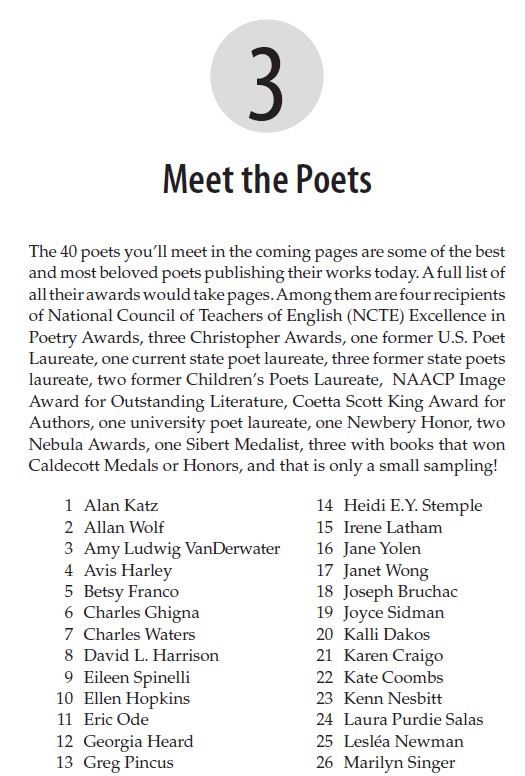
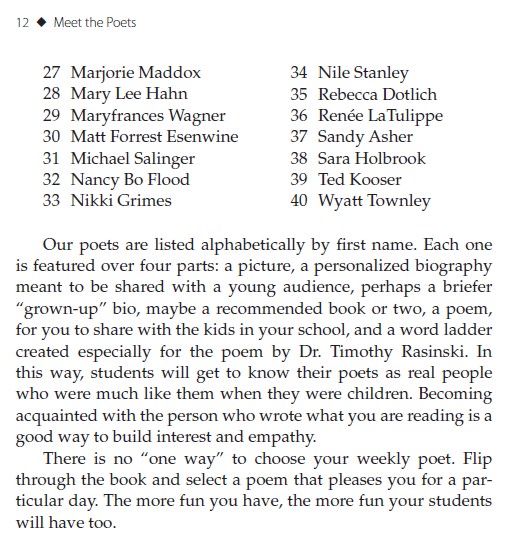
Write Away! Ideas to prompt writing
“[There is} a deep connection between how students read, write, and communicate, and how they develop socially and emotionally.” ~ Justina Schlund, Director of Field Learning for CASEL
Explore five simple ways to write five types of poems with Piglet and his best friend Squirrel in the charming book You’re a Poet: Ways to Start Writing Poems by Sean Taylor, illustrated by Sam Usher.
What is the title of your favorite poem? Why is it your favorite?
Amy Ludwig VanDerwater’s The Poem Farm blog offers a bevy of poems and prompts for writing your own. Visit The Poem Farm, become inspired, and write away!
Visit Sylvia Vardell’s Poetry for Children blog for more ideas and resources.
Poetry Break Related poetry to recite before or following the reading of this book
Poetry breaks fit perfectly into the framework of the school day. These brief moments can signal change, smooth or frame transitions—from beginning or ending the day to lining up for lunch; from zipping up backpacks and jackets to shifting from one subject to the next. Poetry breaks can reset mood or tone, providing a moment to pause, reflect, and breathe. Reading a poem aloud typically takes less than a minute, yet it can introduce or reinforce a concept, provide clarity, celebrate language, exemplify rhythm, enhance vocabulary, expand understanding, increase attention span, initiate reflection, spark imagination, or simply summon a giggle. And, poetry soothes and strengthens the spirit.
“Poetry builds resilience in kids and adults; it fosters Social and Emotional Learning. A well-crafted phrase or two in a poem can help us see an experience in an entirely new way.” ~ Elena Aguilar
Sylvia Vardell’s “Quick List of the Learning Benefits of Sharing Poetry with Kids” found in the Introduction of David’s book; reprinted with permission.
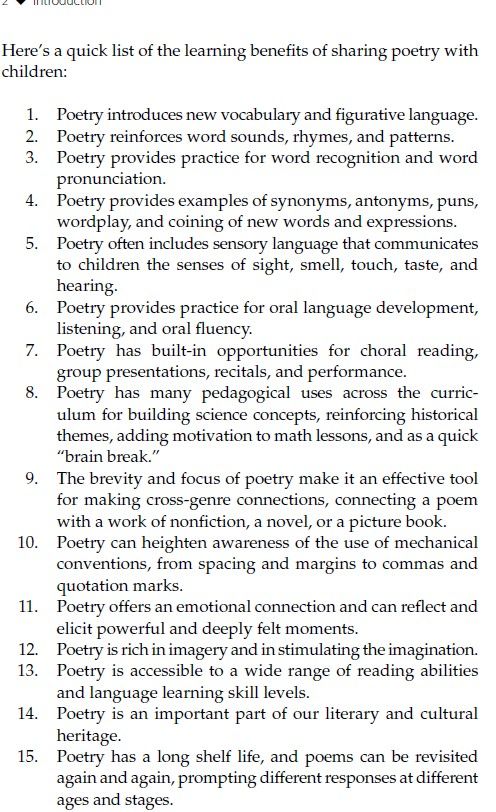
The committee for the NCTE Award for Poetry for Children has selected the 2025 Notable Poetry Books and Verse Novels
The recipient of NCTE’s Excellence in Poetry for Children Award for 2025 is Charles R. Smith Jr.
April is National Poetry Month. Sign up for free poetry lesson plans created by teachers for teachers.
Newly released poetry books and novels in verse:
- Awesome Earth: Concrete Poems Celebrate Caves, Canyons, and Other Fascinating Landforms by Joan Bransfield Graham, illustrated by Tania García
- If I Could Choose A Best Day: Poems of Possibility by Irene Latham and Charles Waters, illustrated by Olivia Sua
- Knucklehead: poems by Tony Keith, Jr. for older children; dubbed by the author as “a love letter to Black boys and men”
- The Poetry of Car Mechanics by Heidi E. Y. Stemple
- Ruthie Rose’s Big Idea by John Schu, illustrated by Holly Hatam
- Safe Harbor by Padma Venkatraman; expertly crafted novel in verse that has Earth Day themes as well
- Wise Up! Wise Down! poems by John Agard and JonArno Lawson, illustrated by Satoshi Kitamura
- You’re a Poet: Ways to Start Writing Poems by Sean Taylor, illustrated by Sam Usher
See also David’s Wild Brunch: Poems About How Creatures Eat illustrated by Giles Laroche, a School Library Journal Best Book of Poetry, 2024 (pictured below).
Additional Children’s Book Corner posts celebrating poetry
- Eb & Flow middle grade novel in verse
- Garvey’s Choice middle grade graphic novel in verse
- Leafy Landmarks: Travels with Trees (also an excellent choice for Earth Day)
- Tag Your Dream: Poems of Play and Persistence
- Tell Me Why the Jack Pine Grows middle grade novel in verse
- Write! Write! Write!
Visit Michelle Schaub‘s Poetry Boost blog throughout the month of April where each weekday a brief video of a children’s poet presenting one of their recently published poems will be featured.
Explore a variety of resources for Shel Silverstein’s poetry.
TeachingBooks has an extensive collection of teaching ideas and resources for National Poetry Month.
See also Amy Ludwig VanDerwater’s resource for educators, Poems Are Teachers: How Studying Poetry Strengthens Writing in All Genres.
Check out David’s recorded columns @PoetryfromDailyLife launching mid-April on You Tube.
And Then There’s This…
Enrichment activities, related books, online resources, craft projects, and ideas for further study
Learn more about David’s life in his autobiography, This Life. Read his interview about the book.
Earth Day is April 22.
Book Collection Suggestions
Earth Day-related books by David (which are also poetry books)
- A Tree Is A Community by David L. Harrison, illustrated by Kate Cosgrove (Activity Sheet)
- And the Bullfrogs Sing by David L. Harrison, illustrated by Kate Cosgrove
- The Dirt Book: Poems About Animals That Live Beneath Our Feet by David L. Harrison, illustrated by Kate Cosgrove
Recently released books with Earth Day-related themes:
- Alfred Blooms by Carrie Kruck, illustrated by Carmen Mok
- Awesome Earth: Concrete Poems Celebrate Caves, Canyons, and Other Fascinating Landforms by Joan Bransfield Graham, illustrated by Tania García
- Beansprout by Sarah Lynne Reul
- The Girl Who Tested the Waters: Ellen Swallow, Environmental Scientist by Patricia Daniele, illustrated by Junyi Wu
- Goose Egg Island by Julia Richardson, illustrated by Meneka Repka
- Growing Green: A First Book of Gardening by Daniela Sosa
- History Smashers: Earth Day and the Environment by Kate Messner, illustrated by Justin Greenwood
- How to Explain Climate Science to a Grown-Up by Ruth Spiro, illustrated by Teresa Martínez
- Meena and the Microbiome by Dr. Majdi Osman, illustrated by Teresa Martínez
- Night Walk by Jason Cockcroft
- Over in the Garden by Janna Matthies, illustrated by Tisha Lee
- Pine Cone Regrown: How One Species Thrives After Fire by Elisa Boxer, illustrated by Keven & Kristen Howdeshell
- Safe Harbor by Padma Venkatraman; novel in verse for middle graders
- Seasons on the Farm by Chelsea Tornetto, illustrated by Karen Bunting
- When Night Comes Calling by Cynthia Schumerth, illustrated by Sheryl Murray
- You Are a Wildlife Warrior: Saving Animals & the Planet by Smriti Prasadam-Halls, illustrated by Ramona Kaulitzki
See also my chapter book, The Adventure of the Big Fish by the Small Creek (Book 2 in the Cayuga Island Kids series); recipient of the Ben Franklin Silver Award for Young Reader Fiction.
Have a title to suggest? Scroll down to add it in the Comments section at the end of this post.
Want to receive Children’s Book Corner each month? Sign up here. We never sell or share subscriber information.
Meet the Author
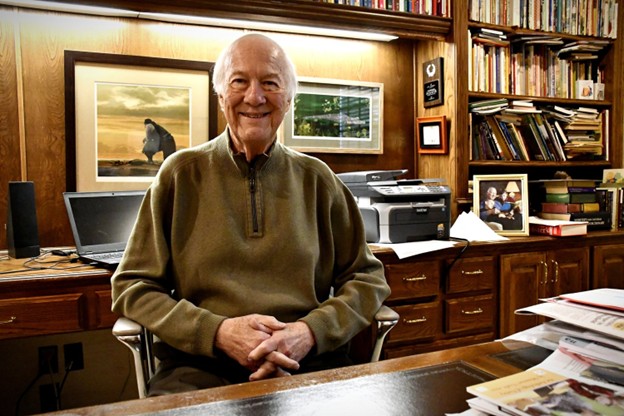
David L. Harrison
David L. Harrison is Missouri’s 7th Poet Laureate (2023-2025) and longtime poet laureate for Drury University. He has published one hundred ten titles that have earned dozens of honors, including the Christopher Award for The Book of Giant Stories. His work has been translated into more than a dozen languages, anthologized more than two hundred times, and appeared in over eighty magazines and professional journals. In Springfield, MO, David Harrison Elementary School is named for him. His poem, “My Book,” is sandblasted into The Children’s Garden sidewalk at the Burton Barr Library in Phoenix, Arizona and painted on a bookmobile in Pueblo, Colorado. David’s poetry inspired Sandy Asher’s popular, award-winning school plays, Somebody Catch My Homework and Jesse and Grace, and has been set to music and performed for numerous live audiences. In 2007, the Missouri Librarian Association presented David with its Literacy Award for the body of his work. David holds two degrees in science and two honorary doctorates of letters (MSU and Drury University). He regularly speaks at conferences and visits schools. David lives with his wife, Sandy, a retired guidance counselor and business owner.
Backstory: Q & A with David L. Harrison
I invited David to join me at the Children’s Book Corner specifically in April, National Poetry month, after having read his interview about 40 Poems for 40 Weeks on Kathy Temean’s Writing and Illustrating blog. We have since enjoyed getting to know each other and our mutual interests. We even discovered that we share the same publisher—this book and my Empowering Families are published by Routledge Eye on Education. I’m pleased to introduce David and his wide array of books and deep knowledge about children’s poetry with you this month on Children’s Book Corner.
Judy Bradbury: Tell us about this project: What seeded its creation? How did you land on the structure or format?
David L. Harrison: I’m blessed to have a school named in my honor. The librarian at David Harrison Elementary in Springfield, Missouri — Dr. Angela Knight — is outstanding. One day Angela told me that she reads one of my poems every week to the whole student body. She multiplies each poem by the school’s enrollment and adds that number of weekly poetry exposures to the growing total. In that way she was not only making sure that every child heard at least one poem per week during the 40-week school year but was also providing a prompt for teachers to find other uses for poetry in their classrooms. First thought in my head was to make a book inspired by Angela’s practice.
JB: What a task to determine which poets to include in this resource! How did you decide?
DH: If there are 40 weeks in a typical school year, I would want an anthology with 40 poems by 40 poets. I know that many poets, good ones who understand how to write for young people. I also know Dr. Timothy Rasinski, professor emeritus from Kent State University. We’ve been friends for twenty-five years and have written half a dozen books together. In two Stanford University studies (2021, 2023), Rasinski was named among the top 2% of the world’s scientists for his extensive body of research and publishing about early literacy. Teachers everywhere love his word ladders, a great tool for developing fluency skills.
JB: What is your favorite aspect of the book? Why?
DH: Not many books are created with librarians in mind. This idea came from a librarian, and I wanted it to be developed with librarians in mind. Of course it would be for teachers, too, and families, and anyone else who reads to children, but this was going to be a resource not only for libraries but for librarians themselves. I wanted to make it easy for them to do as Angela Knight was doing, read a poem a week to the kids in their schools.
JB: I am also a co-author of a Routledge, Eye on Education Book, Empowering Families: Practical Ways to Involve Parents in Boosting Literacy, and I know that the process of collaborating on writing a book is much different from writing solo. 40 Poems for 40 Weeks is co-authored by the esteemed educator and academician Timothy V. Rasinski. How did you and Tim decide to team up? Tell us about your collaboration in creating this book.
DH: Tim is a professor and I am a poet. For certain kinds of books, we make a good team. We got our heads together and mapped out a strategy for this new anthology. My vision was to dedicate four pages for each poet in the book. The idea was to introduce poets to children in ways that would extend beyond the words of their poems on a page. We would feature a picture, a kid-friendly bio, and a poem, and Tim would create a word ladder for every poem. Furthermore, we would invite each poet to suggest up to five other books of poetry that young readers would like. That list alone would make our book a unique, valuable resource for librarians. I sent out my invitation to the poets I wanted. All but two or three agreed and I quickly filled in with enough others to make the 40. We were in business.
JB: Tell us about a challenge you faced in the creation of 40 Poems for 40 Weeks, or provide a memorable (or humorous!) anecdote related to the writing of the book.
DH: Tim and I agreed to invite Sylvia Vardell, professor emeritus from Texas Woman’s University, to write the introduction and ask Angela Knight to write a forward. Keeping all the correspondence straight with 39 poets (I was the 40th) plus Tim, Sylvia, and Angela was a challenge. I set up a file for each one and spent a lot of time answering questions and trying to keep those growing files straight.
JB: What is one unexpected joy that came from the creation of 40 Poems for 40 Weeks?
DH: There were many joys. I loved reading each poem as it came in. Former United States Poet Laureate Ted Kooser contributed a poem. So did some state poets laureates. So did dozens of really gifted children’s poets; Jane Yolen, Nikki Grimes, Joyce Sidman, Kenn Nesbitt, Marilyn Singer, Joseph Bruchac, Charles Ghigna…the list goes on. And I loved reading their one-page bios and learning more about them. Kids are going to fall in love with these people!
JB: What would surprise readers to learn about you or about the creation of 40 Poems for 40 Weeks?
DH: My background surprises many people. I have two degrees in biology, including a master’s degree from Emory University in parasitology (yup, the study of parasites). I became a scientist called a pharmacologist in a laboratory for a pharmaceutical company. Later, I became a greeting card editor and still later owned and managed a concrete block manufacturing company for 36 years.
JB: Who do you perceive your target audience to be and why?
DH: Good poems often appeal to a wide range of ages and that’s true of the majority of poems in 40 Poems for 40 Weeks. However, many of the poets I invited to participate are best known for their poems for elementary students in the general grade range of 3-5. That’s the time when many children fall in love with poetry and maintain that love over a lifetime. Our publisher and we agreed to target the book for Grades 3-5 but it’s highly likely that younger kids will get most of the poems and adults are going to enjoy them all.
JB: What do you hope educators will take away from 40 Poems for 40 Weeks?
DH: Thanks to all the research into early literacy by Tim Rasinski and numerous others, we know that poetry is a wonderful tool – many say the best – for helping children develop reading skills by expanding vocabulary, learning how to understand and manipulate the sounds of words, getting the cadence of our spoken/written language, and overall ready fluency. But getting poetry into classrooms can be difficult and is not universally accepted by busy teachers who haven’t developed the habit of finding poems that serve their needs and making poetry part of their daily routines. That’s why I was so taken by Angela Knight’s habit as a librarian to make sure kids in her school heard at least one poem every week. That’s why I wanted to do this book.
JB: How do you see 40 Poems for 40 Weeks connecting to curriculum or being used in learning settings?
DH: The way we put the book together makes it easy to adapt into normal daily routines. The poems themselves are ideal for group reading, echo reading, choral reading, performing, recording, and so on. The bios offer opportunities to discuss individual poets and perform compare/contrast discussions, and Tim’s word ladders are teacher-favorite tools in classrooms across America and beyond.
JB: What need(s) does this book satisfy?
DH: There are many excellent collections of poems in school libraries, nearly all on specific themes. No, or little, information is provided about the poets as people, like the kids listening might grow up to be. One of the major contributions of this anthology is that it is written specifically with the idea of introducing students to the people who are writing the poems they are enjoying, making the idea of writing their own poems a reasonable, natural next step.
JB: If you could ask your readers (of this professional resource) a question, what would it be?
DH: Richard Allington, professor of education emeritus at University of Tennessee, served as president of International Reading Association (IRA), as president of the National Reading Conference, and as a member of the International Reading Association board of directors. He told elementary classroom teachers that they should have in their rooms a library of at least 100 books that their students loved. He told them that reading should be an integral part of every subject they teach. I would ask our readers to add to Allington’s advice by making sure that poetry is well represented in classroom collections as well as in the school library.
JB: And, as an author and poet of several shelves of books for young readers, if you could ask those readers a question, what would it be?
DH: I would say to students that learning to read is a gift we give ourselves. It’s a key that opens doors leading to all sorts of adventures. When we walk into a room full of books, we are introduced to smart, creative people from all over the world and from the present backward in time before anyone alive today was born. The more of those books we read over our lifetime, the more we learn about what it means to be human, the better we understand the world we live in, and the more pure pleasure we will add to our lives. And don’t forget the poetry!
JB: What do you remember about the first book that made an impact on you?
DH: The first book I ever read all by myself. It was a moment of immense pride. I could read! I could pick up anything – a cereal box, a magazine, newspaper, a book – and I could read it! It meant freedom. I didn’t have a word for it then, but it was power. It made me part of the great world around me. Decades later I wrote a poem about that moment called “My Book!” Today the poem is sandblasted into the sidewalk into The Children’s Garden at the Burton Barr Library in Phoenix, Arizona and painted around a bookmobile in Pueblo, Colorado.
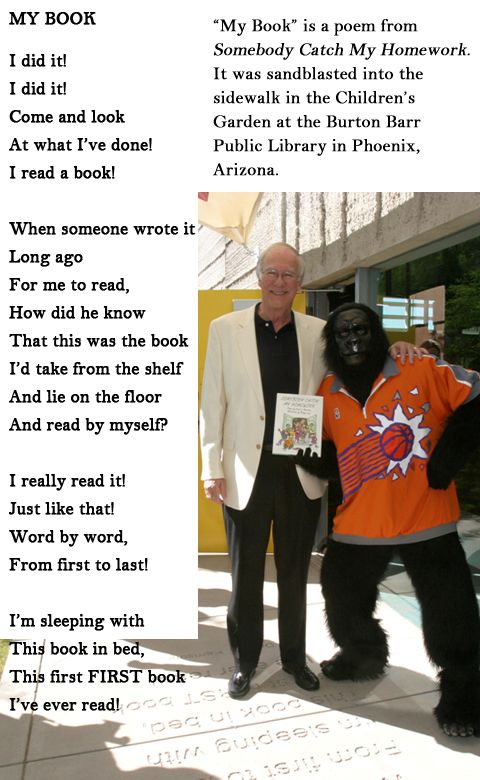
JB: What project(s) are you currently working on?
DH: I am teaming on two books with other poets and one of my own. Much of my time is taken with a project to record 100 issues of my weekly newspaper column, Poetry from Daily Life. More than sixty guest poets from across the United State and three other countries are being recorded reading their work. The goal is to create a free video library that will be available worldwide wherever internet service is available. The first 50 recordings are set to be introduced on YouTube this month (April).
Also written by David L. Harrison (To view all of David’s many books, visit his website.)
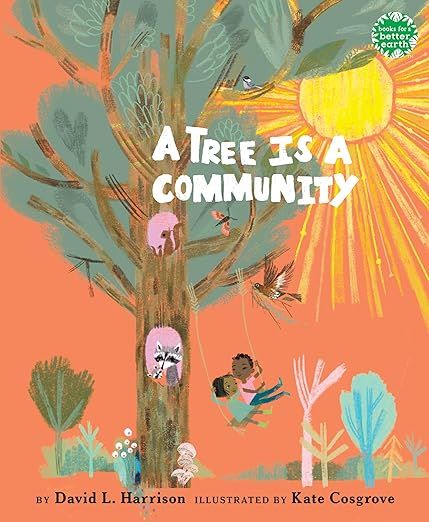
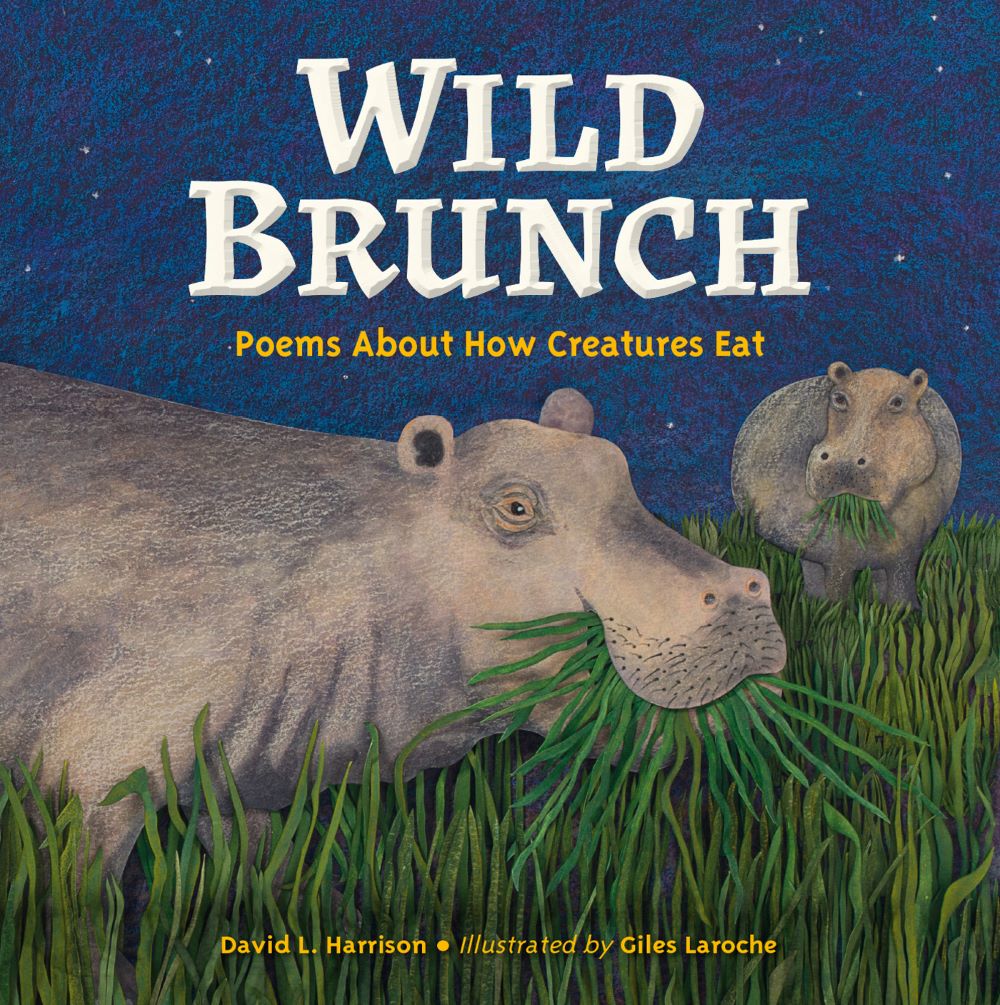
Sidebar Spotlight New releases of note
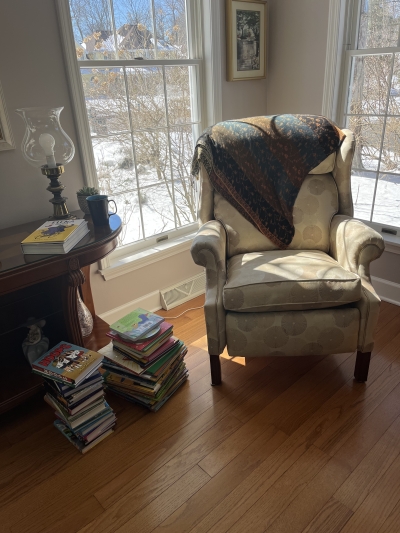
Each month I receive several boxes of books to review from various publishers. As I read and peruse the books, I place them in two piles: those that I will consider featuring on the blog, and those that don’t fit the mission or theme of Children’s Book Corner blog for whatever reason. I highlight some of the books in the “possible” pile on Mondays (most weeks) on Instagram. Ultimately, I choose the one new release I will feature on my monthly blog post. Yet there are many terrific books I wish I could give a shout-out to, even if I can’t write an entire post about each one. So, Sidebar Spotlight is a means of giving a nod to new releases that, in my opinion, are noteworthy. I’ve linked each title to Bookshop so you can learn more. Happy reading, friends! And feel free to comment on these or other new books below.
Dear Bookstore by Emily Arrow, illustrated by Geneviéve Godbout has all the good feels about bookstores and bookshop owners and how they positively impact our communities as well as our personal lives. The illustrations are magical; they remind me of my favorite indie bookstore, Alice, Ever After Books. Ages 4-8+
Safe Harbor by Padma Venkatraman is an impeccably crafted novel in verse for middle graders about the power of music, forging friendships, animal rescue, and more woven into a compelling story centering on finding home in a new land.
You’re a Poet: Ways to Start Writing Poems by Sean Taylor, illustrated by Sam Usher Explore five simple ways to write five types of poems with Piglet and his best friend Squirrel in this utterly adorable book.
News, Updates, & Items of Interest
If you would like the monthly Children’s Book Corner blog post delivered to your inbox, sign up here. We never sell or share subscriber information.
Children’s Book Week takes place May 5-11. The 2025 slogan is “An Ocean of Stories.” Schools, libraries, bookstores, and individuals can sign up to participate. Each location may receive two free copies of Julie Flett’s poster. Also free are a variety of online resources including those from twenty-two newly added authors and illustrators. Find bookmarks, coloring sheets, fun facts, story starters, poems, riddles, the Story Ocean Club, and more.
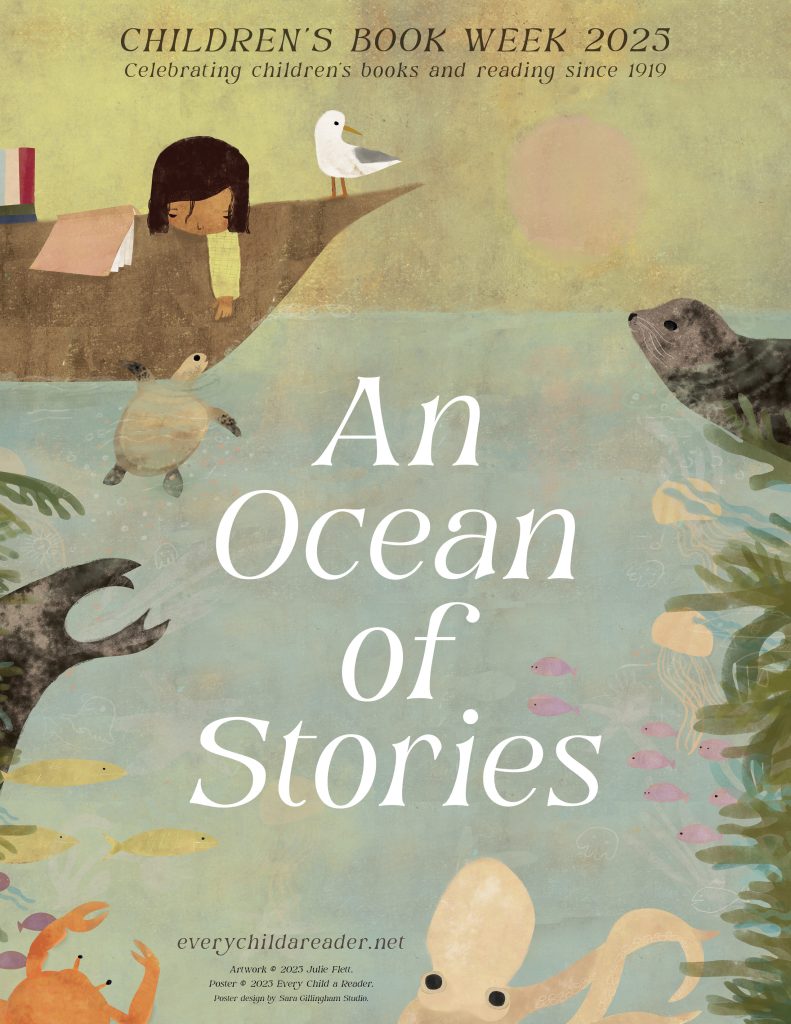
Find where my books and I will be on my Events page, including what is sure to be a fun stint: I’m pitching in as an “author bookseller” on Independent Bookstore Day at one of my favorite children’s bookstores, Alice, Ever After Books on Saturday, April 26!
I am currently booking school visits and professional development sessions for 2025-26.
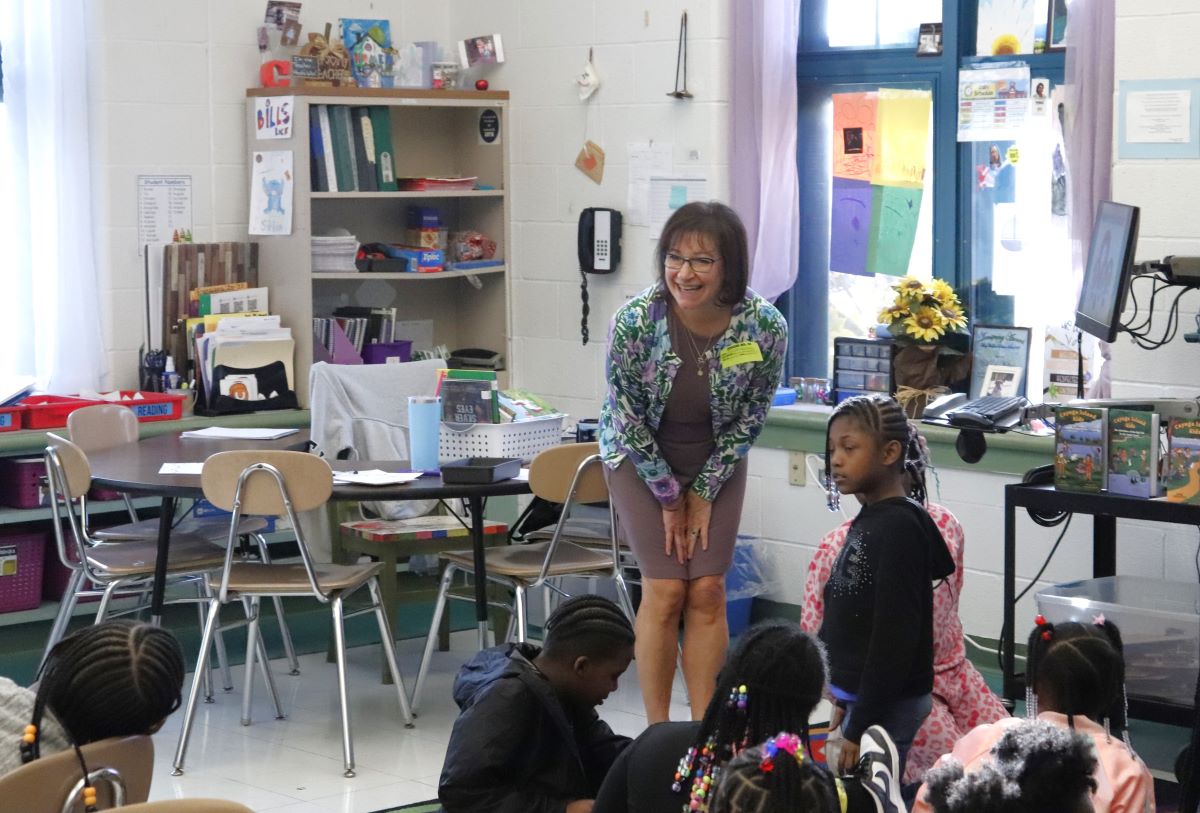
Photo credit: Jody LaRose
Find information and contact me to discuss a visit tailored to meet your school’s needs.
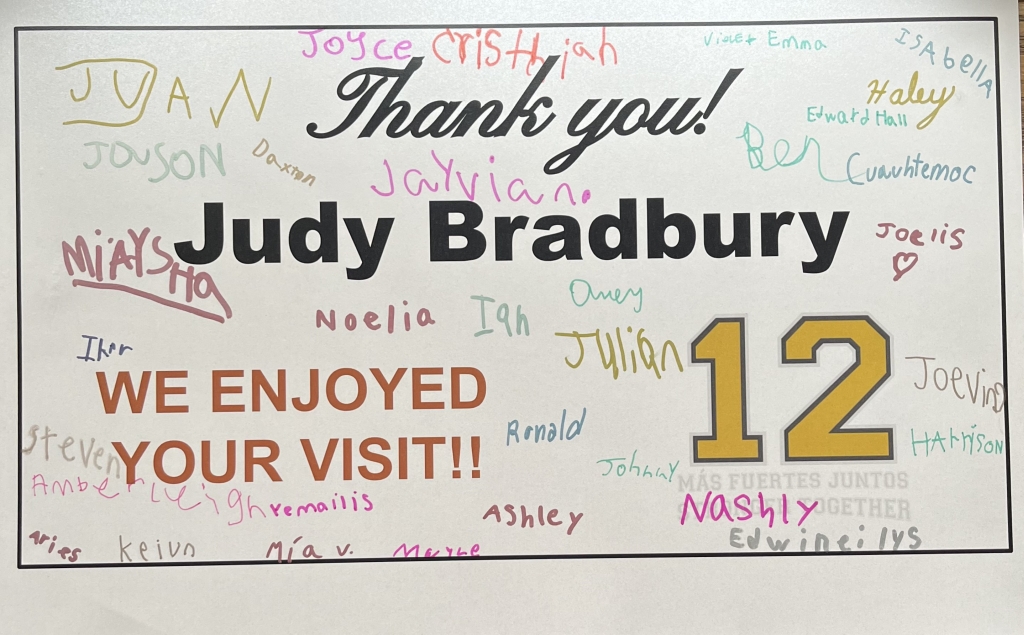
A note from a teacher whose students I recently visited:
Thank you so much for coming to meet with my students. You were wonderful, answering their questions and explaining how you wrote the book. We all loved it! Here are some illustrated thank you notes the students made for you. Thank you again!
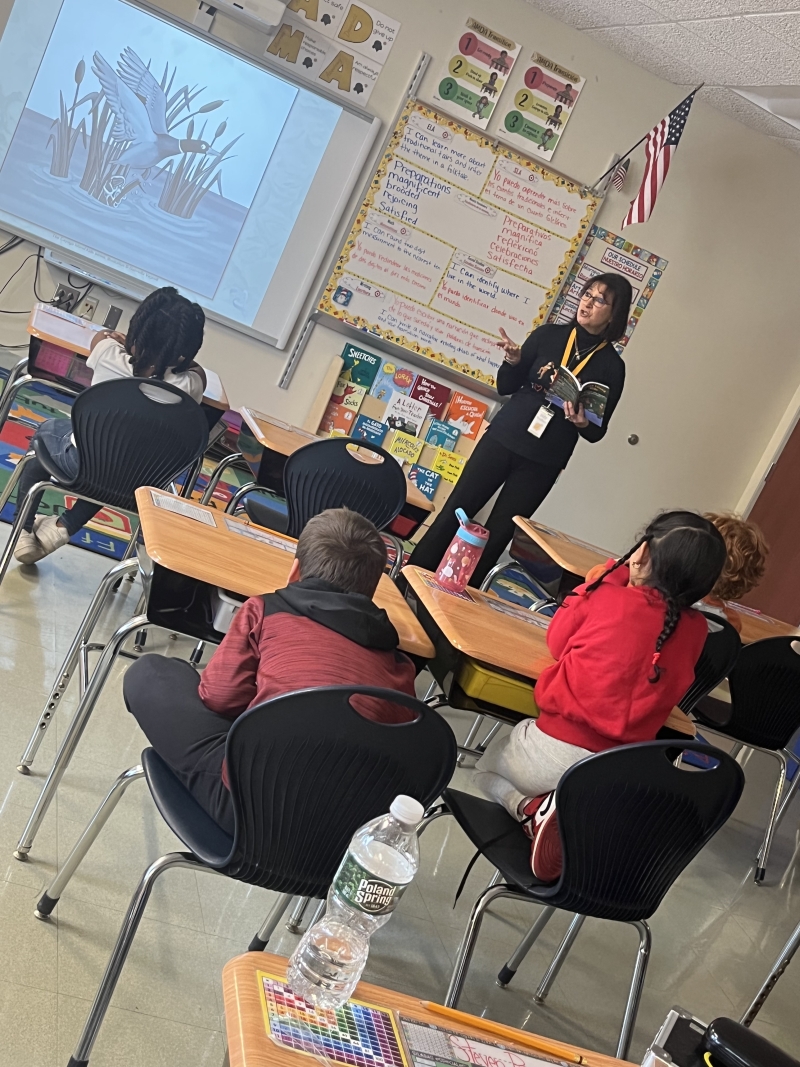
Read-aloud of a portion of Cayuga Island Kids Book 2, The Adventure of the Big Fish by the Small Creek
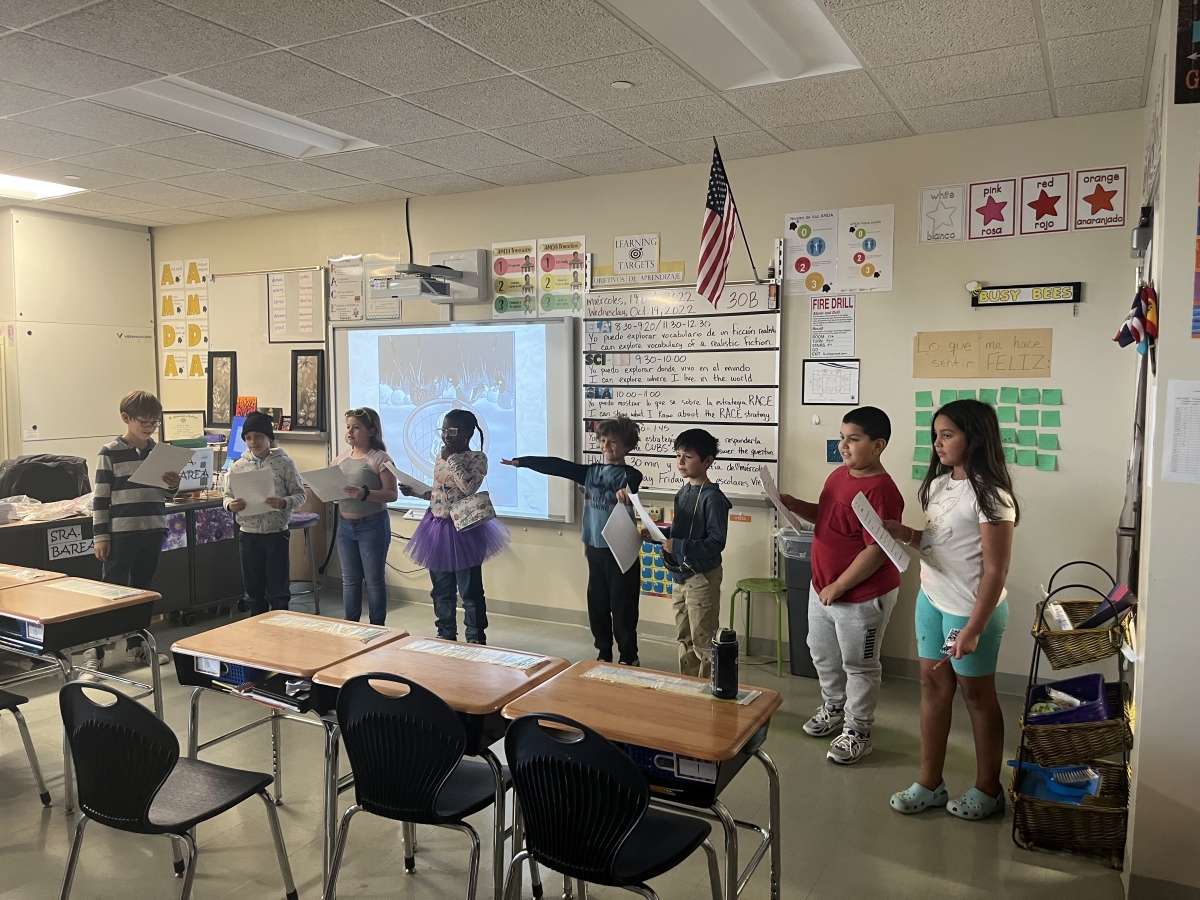
Readers Theater, complete with props!
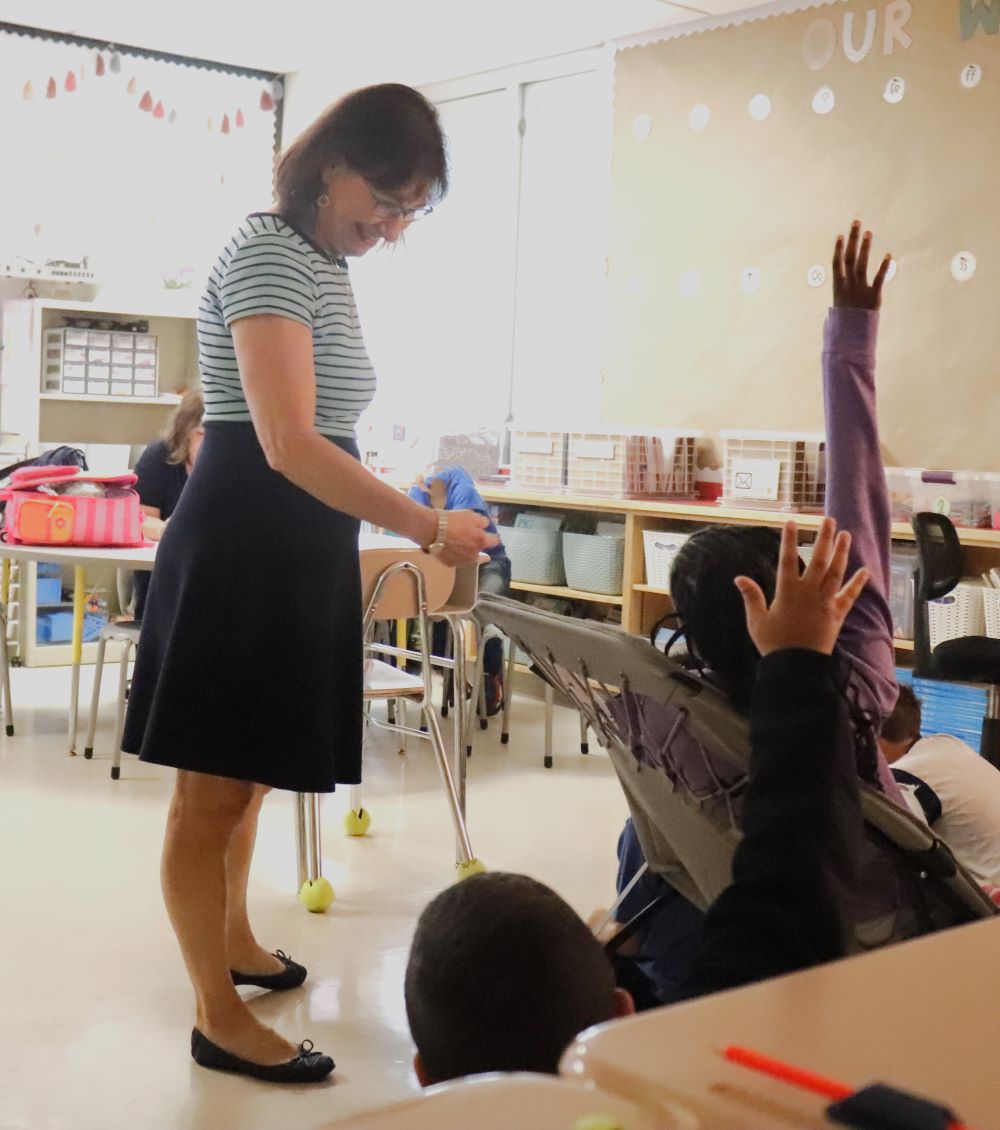
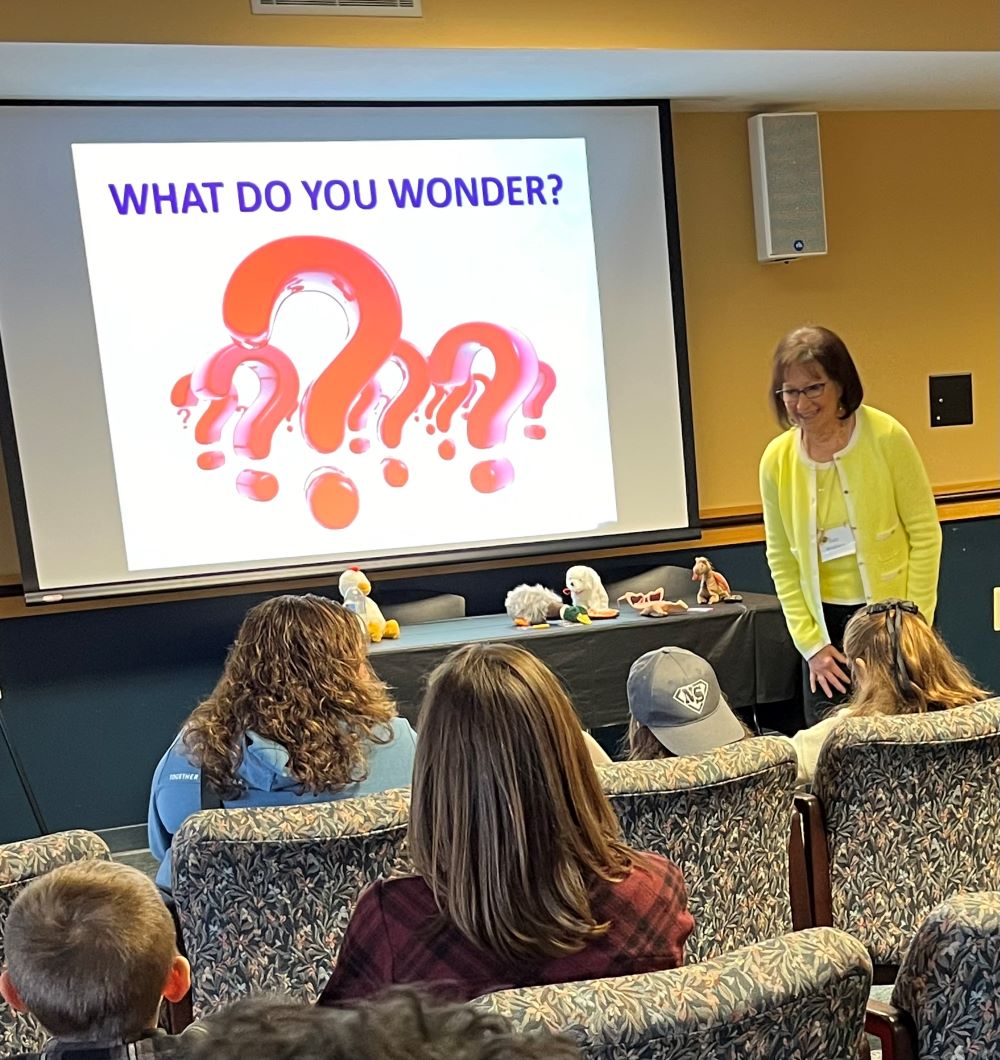
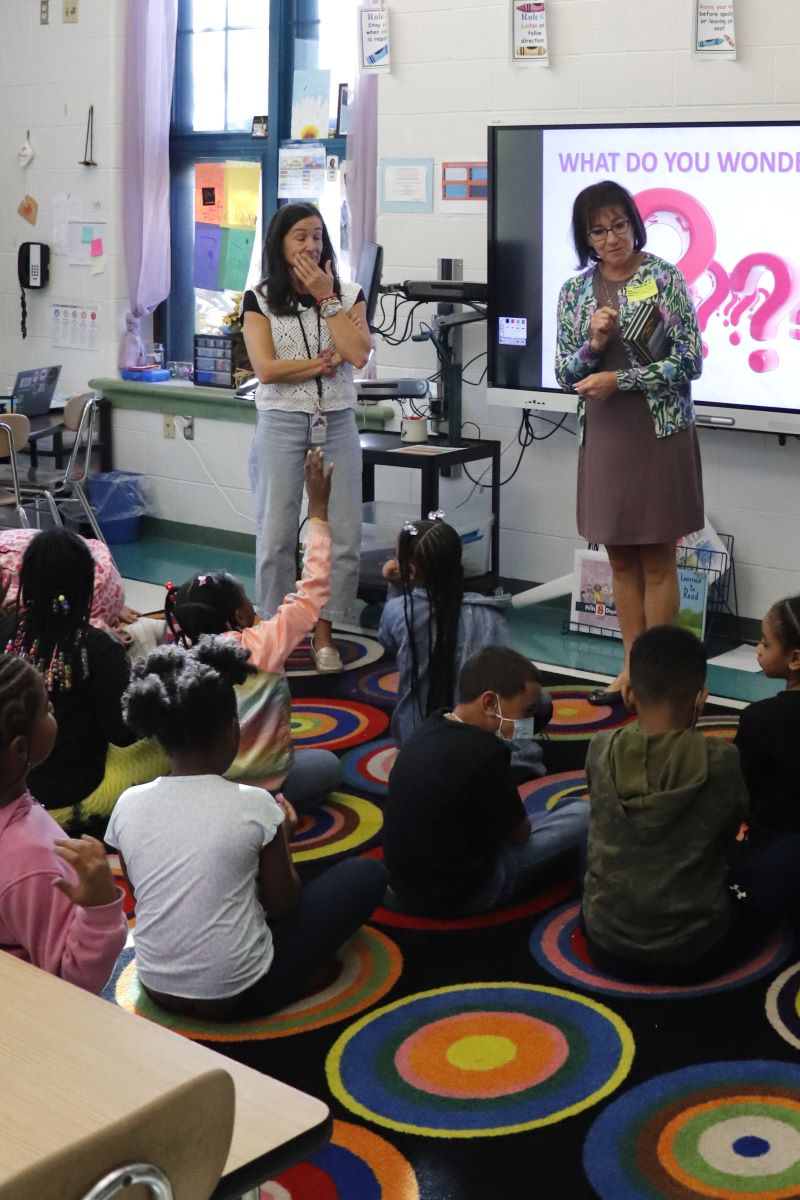
And here’s a note I received after presenting “SEL-Related Children’s Books with Curriculum Tie-Ins” to teachers and librarians of Grades Pre-K—Grade 6:
Thanks so much for presenting! I heard wonderful things about your workshop! One person mentioned to me that you were so organized and passionate. They also loved seeing all the children’s books you brought with you!
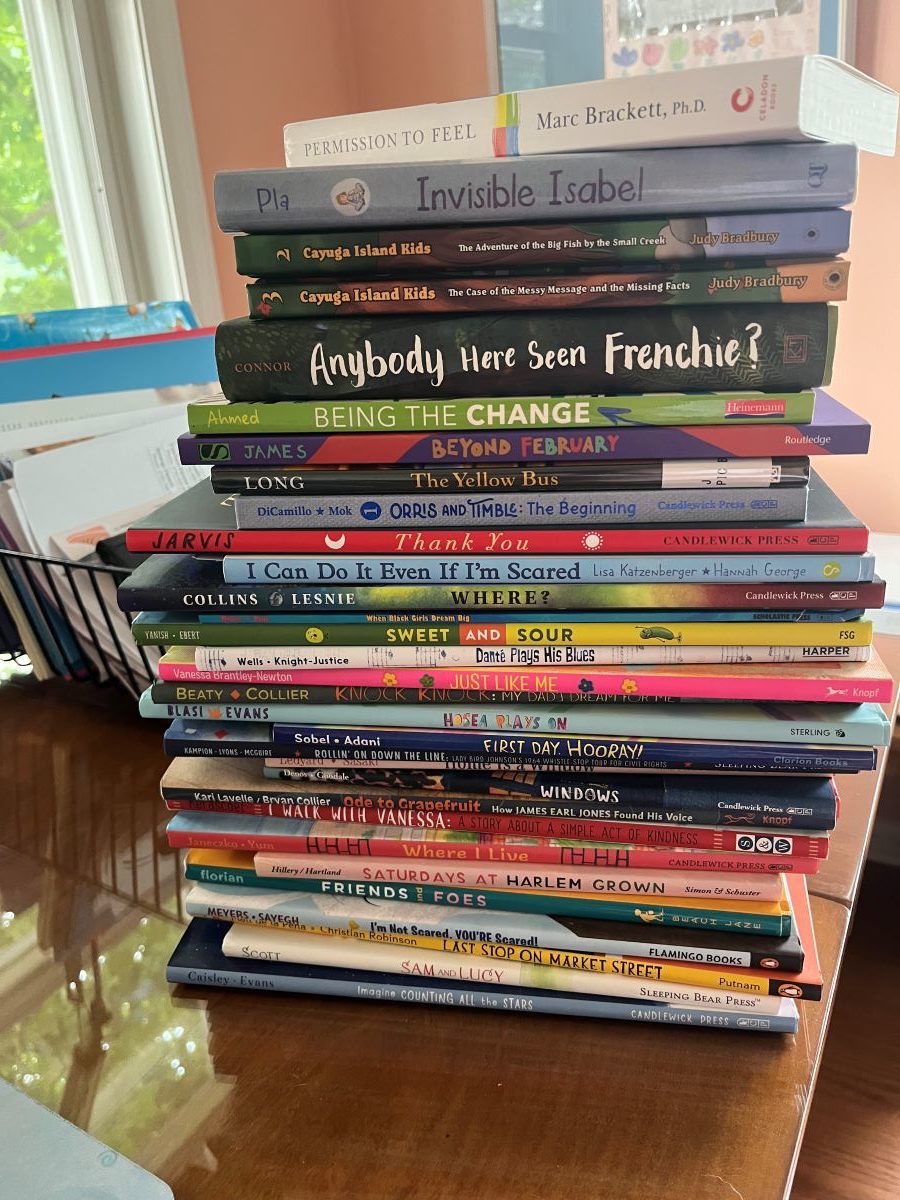
Find my books packaged as a series at your favorite bookshop or purchase directly from the publisher and receive a gift with purchase! Individual titles are also available in hard, softcover, and e-book versions.
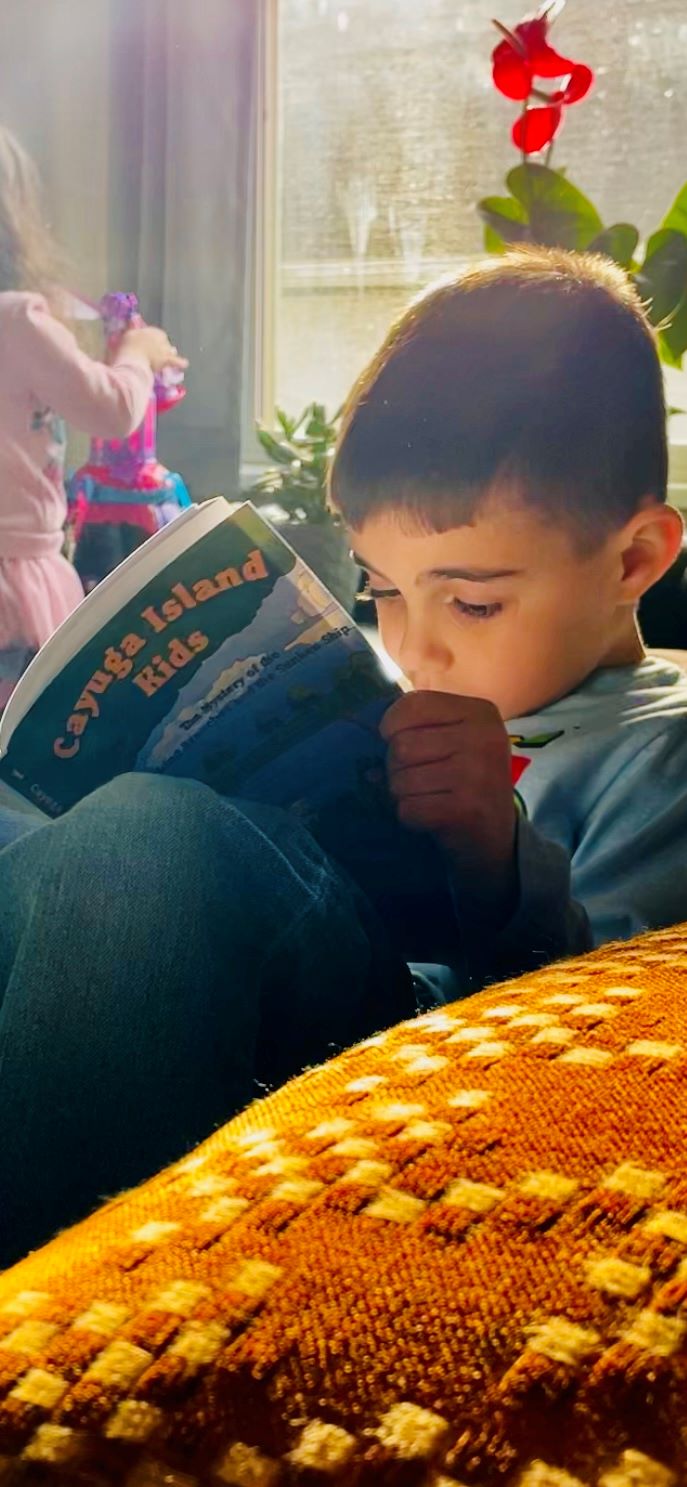
Kindness tip: If you read and like a book, consider posting a review on GoodReads, social media, or on Amazon (if you bought it there). Authors and illustrators appreciate the shout-out. Even a one-sentence comment increases visibility of a book. Also consider placing a request with your local library to purchase a copy–another free way to support a book you recommend!
Over to You…
Join the conversation! Offer your thoughts related to this month’s post:
What poetry book do you recommend? Share the title, author, illustrator, and suggested age or grade range.
You are also welcome to post a general comment.
Thanks for sharing!
Final Thought
“Poetry is a bucket for holding truth.”
~ Adrian Mitchell
Like what you’ve read today? Have Children’s Book Corner delivered to your inbox each month. Sign up here. We never sell or share subscriber information.

